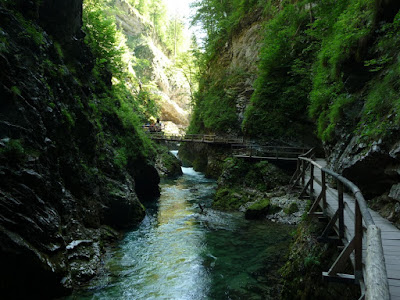Our last day in Slovenia,
Juillet 14, we drove a bit of the Julian Alps, from Lake Bled up and over the Vrsic pass, down the Soca valley, and then back into Italy, spending the night at a huge
sosta in Udine. The Julian Alps are at the intersection of Italy, Austria, and Slovenia--Alpine country indeed--
the Julians are not quite as spectacular as the nearby Dolomites, but definitely in that league.
 |
Slovenian hay drying racks, one of the country's icons; sometimes used as bill-
boards, too |
 |
| Could be anywhere in Alpine country...Italy, Switzerland, Slovenia, Austria... |
 |
At a turn-out featuring Slovenia's big mountain, Mount Triglav; another helpful
bronze model |
 |
Local parish priest, incensed that Mount Triglav was owned
by Germans, purchased the summit so that Slovenia's
tallest mountain, 9,300+ would be, at the top, Slovenian;
details below |
 |
| Mount Triglav, there in the center, further away |
 |
| More drying racks, actually drying hay |
 |
| And now we're on our way up the pass; each of the 50 hairpin turns is numbered |
 |
The Russian Church, so-called because it was built by Russian POWs , who
also built the road and much other WWI infrastructure; a POW cemetery is
nearby; as we'll see in the next post, the Italian/Austrian theater, so to speak,
was next only to the French/Belgian/German theater in terms of casualties |
 |
| Huge alpine window |
 |
Near the top of the pass, another huge cairn city; the Slovenians certainly rival
the Norwegians in the building of these things |
 |
Vrsic Pass was a bit of a trial for Le Duc with its 1.9 liter turdo-diesel engine; we
only stopped a couple times to let the engine cool; the climb to Andorra in the
Pyrenees was worse, but that was in 90 degree weather; the climb to San Marino,
in another couple days, would be a still greater test, 18% and 20% inclines |
 |
| View from the pass, looking down to the Soca valley |







































































